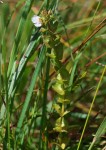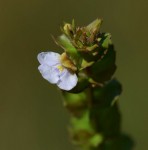| Home | > | List of families | > | Linderniaceae | > | Crepidorhopalon | > | namuliensis |
Crepidorhopalon namuliensis
Selected images: Click on each image to see a larger version and details of the record View all images (2)
Detailed records: Display species records QDS maps by: Google Maps Point records by Google Maps
Species details: Click on each item to see an explanation of that item (Note: opens a new window)
| Synonyms: | |
| Common names: | |
| Frequency: | |
| Status: | Native |
| Description: |
Perennial herb, with erect, scrambling or trailing 4-angled stems, up to 50 cm long or more, hairy with some hairs orange-tipped glandular. Leaves sessile, opposite, pairs set 10-22 mm apart along the stems, broadly ovate, 9–20 mm long, base rounded or shallowly cordate, margin serrate with 2–5 teeth per margin, 5-7-veined from the base; sparsely puberulous with glandular and eglandular hairs mainly on margin and main veins beneath and with sunken glands drying brown, especially beneath. Flowers axillary, solitary; bracts leaf-like, pedicels up to 6.5 mm long. Calyx 5–7.8 mm long, lobes lanceolate, longest 3.3–4.2 mm long, shortly glandular-pubescent. Corolla 13.5–16.5 mm long, whitish to purple on tube and upper lip, lower lip white or at most tinged pale blue, usually with a yellow patch in the mouth, glandular-puberulous outside, and with pale longer hairs on the upper lip. Capsule ellipsoid, to 7.5 mm long, brown, more or less equal in length to calyx or slightly shorter. |
| Type location: |
Mt Namuli, Mozambique |
| Notes: | |
| Derivation of specific name: | namuliensis: of Mt Namuli in Mozambique, where this species is found. |
| Habitat: | Damp ground in montane grassland. |
| Altitude range: (metres) | 1730 - 1870 m |
| Flowering time: | |
| Worldwide distribution: | Only known from Mt Namuli (Sera de Gurue) in Mozambique. |
| National distribution: | Z |
| Growth form(s): | |
| Endemic status: | Endemic |
| Red data list status: | |
| Insects associated with this species: | |
| Spot characters: | Display spot characters for this species |
| Images last updated: | Sunday 20 October 2019 |
| Literature: |
Darbyshire, I., Timberlake, J., Osborne, J., Rokni, S., Matimele, H., Langa. C., Datizua, C., de Sousa, C., Alves, T., Massingue, A., Hadj-Hammou, J., Dhanda, S., Shah, T., Wursten, B. (2019). The endemic plants of Mozambique: diversity and conservation status Phytotaxa 136 Page 89. Darbyshire, I., Wursten, B., Luke, Q. & Fischer, E. (2019). A revision of the Crepidorhopalon whytei complex (Linderniaceae) in eastern Africa Blumea 64 Pages 169 - 171. Protologue (Includes a picture). |
Other sources of information about Crepidorhopalon namuliensis:
External websites:
African Plants: A Photo Guide (Senckenberg): Crepidorhopalon namuliensisAfrican Plant Database: Crepidorhopalon namuliensis
BHL (Biodiversity Heritage Library): Crepidorhopalon namuliensis
EOL (Encyclopedia of Life): Crepidorhopalon namuliensis
GBIF (Global Biodiversity Information Facility): Crepidorhopalon namuliensis
Google: Web - Images - Scholar
iNaturalist: Crepidorhopalon namuliensis
IPNI (International Plant Names Index): Crepidorhopalon namuliensis
JSTOR Plant Science: Crepidorhopalon namuliensis
Mansfeld World Database of Agricultural and Horticultural Crops: Crepidorhopalon namuliensis
Plants of the World Online: Crepidorhopalon namuliensis
Tropicos: Crepidorhopalon namuliensis
Wikipedia: Crepidorhopalon namuliensis
| Home | > | List of families | > | Linderniaceae | > | Crepidorhopalon | > | namuliensis |

